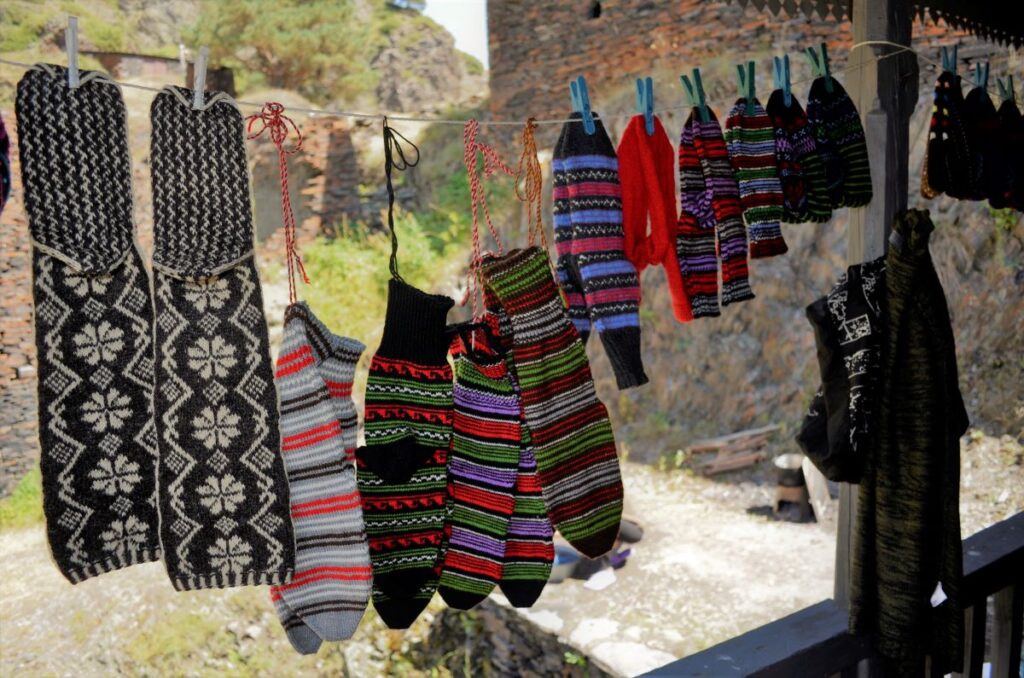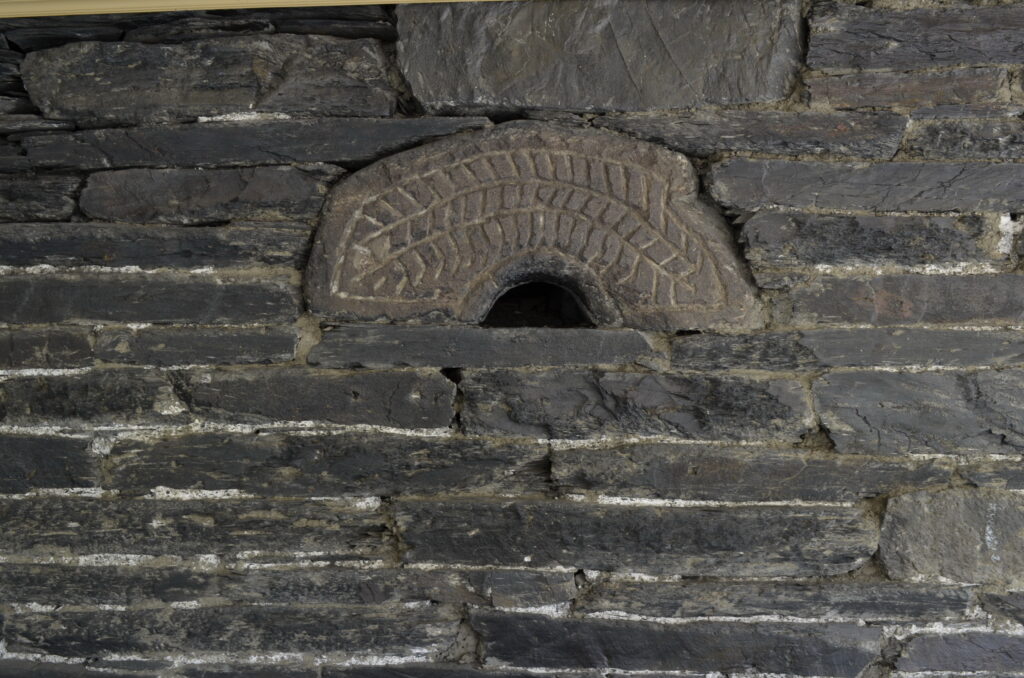The Guild of Weavers
In the mountains, everything is interlinked, much like the intricate threads of an old Georgian tale. One of the finest examples of nature-man collaboration is the unique textile tradition that emerged from sheep breeding and herding practice. Tushetian sheep, grazing on rich, herb-laden pastures, produce an exceptional wool, renowned as the finest in the Caucasus. It is soft, delicate, and lustrous. Legend has it that Tushetian wool absorbs dyes beautifully, retaining its rich colours without fading over time. Thanks to shepherds, this premium wool reaches local artisans and workshops. Currently, several craft studios are scattered across the region, including “The Shepherd’s House,”“Tushetian Rug,”and “Aisi”. Despite these organized workshops, most master weavers, as in ancient times, continue to work from their homes. Thus, Tushetian dwellings, with their intricately carved wooden balconies, transform into magical workshops, and when fresh wool arrives, the true feast of creativity begins.

Tushetian Alchemy – The Art of Dyeing Yarn
The land of Tusheti, like a vast chemical laboratory, is a treasure trove of natural dyes. Here, every local—man, woman, child, or elder—is an alchemist, mastering ancient knowledge of where, when and how to gather specific plants and how to blend them to achieve the perfect hues. Until the late 19th century, dyeing in Tusheti relied solely on natural colorants. They were categorized into two groups: ‘Tushetian dyes’– derived from plants found exclusively in the meadows of Tusheti and ‘Kakhuri’ dyes – brought up from the lowlands of Kakheti. Among the local dyes there are the iconic Caucasian rhododendron, Hypericum, and Berberisroot, also pine and birch trees’ moss, aspen and birch leaves, and lastly soot. It is also worth noting the three signature hues that define the region’s primary colour spectrum: walnut brown, black, and yellow. Each has its unique method of preparation. To achieve the walnut shade, yarn is boiled in the tavshava (Hypericum) solution and then sprinkled with ash before being washed and hung to dry. For black, the tavshava extract is mixed with ‘dzaga’ (mixture of plant), while the yellow is obtained from pine moss. Before starting the dyeing process, artisans meticulously sort the wool by its natural shades—red, white, gray, or mottled—since the base color significantly influences the final hue. Each variation produces a unique undertone after dyeing, adding depth and character to the fabric. Lastly, to master the alchemy of coloring, artisans must carefully select the right dyeing vessel, as it plays a pivotal role in achieving a flawless and enduring hue. According to old Tushetian beliefs, dyes made in cast-iron cauldronsare impervious to time and elements, ensuring their lasting brilliance.

‘Me and My Nabadi’
When archaeologists unearthed the Bedeni Barrows, dated to the 3rd–2nd millennia BCE, they discovered, among numerous artifacts, fragments of fabric and remarkably well-preserved felt pieces, their colors unfaded through the ages. These findings represent the earliest evidence of Georgia’s felting tradition, a craft deeply embedded in the country’s cultural heritage. The art of felting, or nabadi-making, holds profound significance in Georgia, especially in Tusheti, where the process was enriched with unique customs. According to Tushetian tradition, only autumn’s “long-fibered” wool, known as “grdzlovani,” was used for felting. Every felted product, regardless of its form or function, is referred to as a Nabadi. The wool felting method itself is almost identical for all types of Nabadi, yet the duration of felting, the selection of wool by its natural color, and the wool’s quality varied depending on what the masters intended to craft. Spring or early autumn, during warm and sunny weather, was considered the ideal time for felting, as the wisdom of the elders advised: if the wool ‘cools down,’ the felt will not form properly. In Tusheti, the secrets of felting were passed down exclusively through women. Skilled artisans created their works without predefined sketches, allowing for creative spontaneity and individual expression in every piece. Each Nabadi bore a unique character, reflecting the artisan’s ingenuity and the natural beauty of the wool.
The Carpet of Life
Among woolen textiles, the Pardagi (rug) has always held a special place. It represents one of the most distinct and ancient forms of Georgian carpet-making. Symbolically and functionally significant, pardagi was a vital object in everyday life and cultural rituals. Until the mid-20th century, Pardagi was an indispensable companion for travelers, draped over carts to shield passengers from heat and cold. These carpets were woven for household use and were often donated to churches as offerings. The Pardagi was also a key element of a bride’s dowry, symbolizing the hearth and life itself. Brides-to-be would spend months weaving their dowry carpets, pouring their hopes and craftsmanship into these cherished pieces. Even today, the art of carpet weaving thrives in Tushetian households. Their traditional carpets, rugs, and khurjini(woven saddle bags) are crafted on vertical looms called ‘Akazma’. Experts believe that the main enigma of unapparelled Tushetian carpets lies in the perfect harmony of their colours and patterns. The subdued color palette and strict geometric patterns create a delicate interplay of dynamic and static motifs, resulting in a harmonious whole. Two key ornamental motifs dominate Tushetian carpets: The Cross and so called ‘Rkhanakhara’ – a square with outward-facing horn-like spirals, pointing in all four directions. If the first is a vividly Christian symbol, the latter may be deep-rooted with Pagan traditions. Generally speaking, Tushetian rugs with their colors and intricate patterns encapsulate a cultural and historical narrative of the world that, according to some researchers, may reflect both Christian beliefs and ancient, intuitive knowledge passed down through the ages. In the mountains, weaving and felting are not merely crafts but also social and ritualistic practices. Therefore, till these days, ritualic crowding around felting tables continues. Gather around the master weaves and start felting wool, knitting traditional socks, gloves and bags, while the most skilled artisans craft special woven shoes—Chiti, as colourful as Tusheti’s meadows. Sometimes, someone plays the Garmoni (accordion), and together, Tush women create a vibrant, woven world, spinning their own cultural heritage into every stitch and colour.